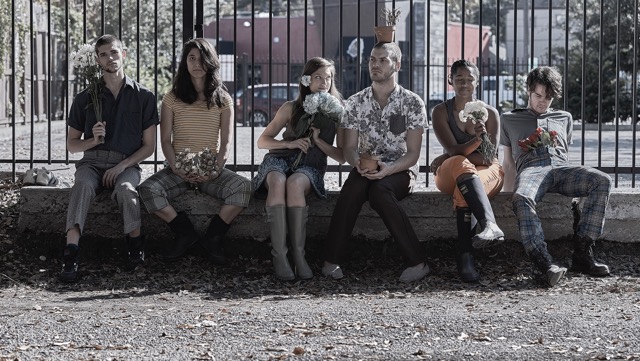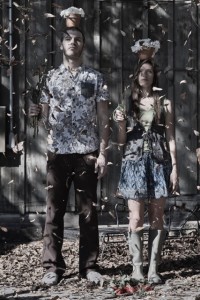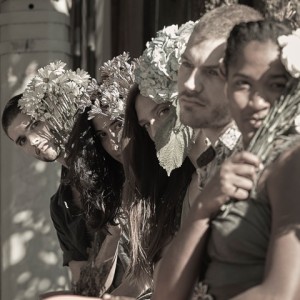Hope Stone Dance Blooms Again with Friday Flowers
by Adam Castañeda
The cultural impact of flowers are examined in Stephen Buchman’s The Reason for Flowers, and for him, a lifelong entomologist, these botanical wonders are not merely decorative flourishes of nature, but wellsprings of inspiration for the human imagination. Hope Stone Dance will perform Friday Flowers, a personal exploration of what flowers mean to choreographer Jane Weiner, on Jan. 15 at the Houston Ballet Center for Dance’s Margaret Williams Alkek Dance Lab at 8 p.m. “I didn’t know if I wanted to create another evening,” explains Weiner. “I started making vignettes of flower pieces, and then I heard Stephen on NPR. After listening to him, I said, all right, I’ll do it.”
Anyone who keeps flowers knows that each species possesses its own charm and its own mysterious power to sooth and nurture. One of my favorite professors told me once about a pair of African violets she bought for herself during a month-long summer residency up north, the striking purple petals the only adornment, and sense of companionship, in a bare apartment. At summer’s end, it was a painful experience to part with them; she made sure of their well-being by gifting them to the kindly housekeeper who kept up the complex. I too, can attest to the gift of comfort offered by the African violet. Weiner’s Friday Flowers will mine the personalities of some familiar faces, including rose, marigold, geranium, black-eyed Susan, carnation, daisy, and chrysanthemum.
Weiner’s celebration (and contemplation) of flowers does not stem from a lifelong love affair with blossoms. “I have a love/hate relationship with flowers,” she says. “And this feeling is connected to my vision of myself.” Much of the emotional content of the concert is drawn from her days as working dancer in New York City. “Flowers to me give the impression of being rich. As a struggling artist, every penny counted, and I wasn’t allowed them.”
As a girl, she felt very connected with flowers, as most children seem to have an innate connection with the spiritual side of nature. But in adulthood, flowers became a status symbol. “There were many times in New York when all I wanted were some fresh flowers, but I just couldn’t afford them.” Her conversation with flowers now is much more open and copacetic.
Dropping by a rehearsal in late December, it’s clear that Weiner has something important to say about each of the flowers on her program. “Marigolds were in my wedding,” she explains. “They were also all over India, and have so much meaning. I really like them because they have a lot of energy.” The marigolds movement is as lush and full of life as the flower itself. The female quartet is filled with cheeky humor and strong, springy partner work, and generates an electric energy that is at once buoyant and joyful, yet somber and reverent. Marigolds are, after all, a holy flower. In Varanasi, that fabled Indian city of the dead, the bright orange flower is used in the final rites of the deceased, in mourning and in celebration.
“Geranium is the heart,” says Weiner of the flower with clustered petals. “The heart is so strong, but it’s also fragile,” which is true of the much favored perennial. Gardeners know that a bed of geraniums is about as hearty as they come, but the blossom itself is extremely delicate, with petals falling at the slightest disturbance. Jane’s sister is named Susan, hence the use of black-eyed Susan. “That was always Susan’s flower, and growing up I always wanted my own flower. I wanted to know where the Jane flower was.” And daisies were a no-brainer. “I love daisies. They’re cheap, quiet, and beautiful.” Whatever the vignette, audiences will be able to experience the vibrant and colorful inner lives of these flowers via Weiner’s trademark movement: big, expansive, and playful in the way only adults with a child’s spirit can be playful.
Friday Flowers sounds like the perfect post-holiday dance concert, a thoughtful and refreshing change of pace from all things Yuletide. So who all is invited to party? Everyone, in fact. Friday Flowers is being presented as a pay-what-you-can performance, which is in direct line with Hope Stone’s “art for all” mission, which is quite revolutionary in the never-ending non-profit grind for funding and resources. “I think the last two years of Hope Stone 2.0 I saw a lot of time and money put into these productions,” explains Weiner. “I had no choice but to charge admission, even though I never recouped.”
Recently, Weiner’s outreach initiatives have taken her to the homeless, which has in turn led to questioning a system that allows a privileged few to experience art, while the rest of the population must go without. Two years ago, when she presented I Scream in the Commerce Street lofts, a group of single moms who lived in the projects down the street stumbled across the dress rehearsal and asked what was going on. Jane told them about the performance, and the next evening about twenty moms and their children showed up to enjoy the performance. Going forward, she wants to move Hope Stone in the direction of presenting work for everyone, and not just a high-price ticket buyers. “I want to marry the two, create pop-up art in a safe environment for my dancers where moms and their kids can see it.”
Adam Castañeda is a dancer, writer, and arts administrator. He is the Executive Director of FrenetiCore, and performs with Suchu Dance, Holding Space Dance Collective, Heather VonReichbauer, and Intuitive African Dance and Drum Culture.






1 Enlightened Reply
Trackback • Comments RSS
Sites That Link to this Post